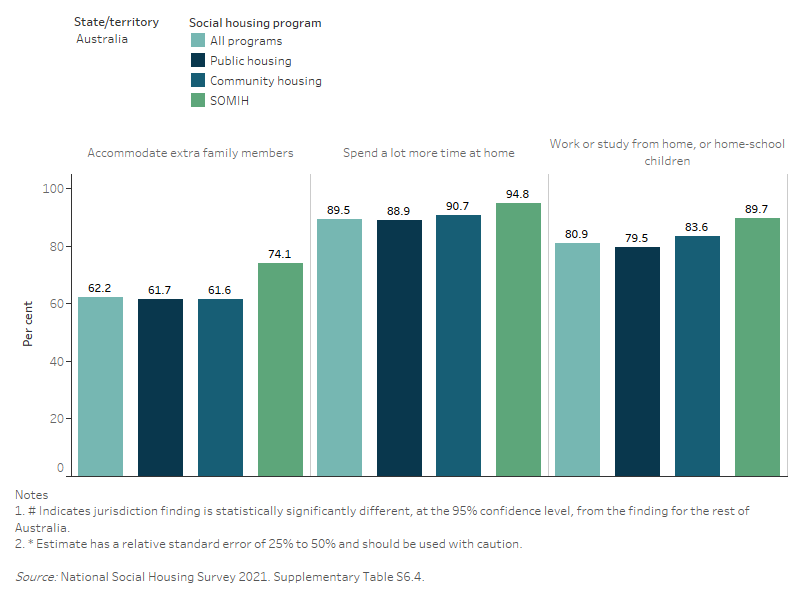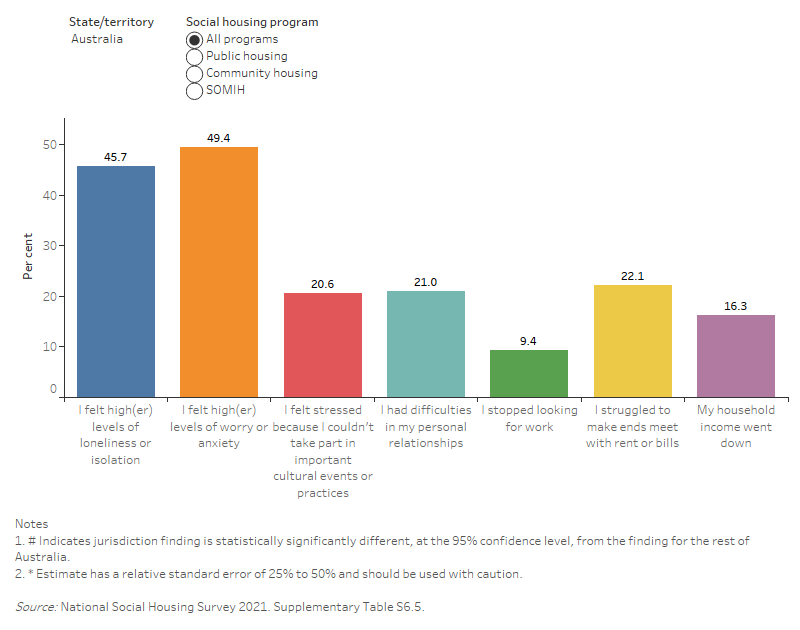COVID-19 pandemic impacts on social housing tenants
On this page:
'Our housing provider gave us updated info and contact details for issues when COVID‑19 impacted access to offices. Phone and emails were replied to reasonably promptly.'
Household needs met during the COVID‑19 pandemic
To understand whether social housing met certain specific needs during the COVID‑19 pandemic, tenants were asked about the situations listed in the box below.
Additional question about needs during COVID‑19
Information about COVID‑related situational needs met by tenants’ homes were obtained from responses to the following question:
'Thinking about your experience during the COVID-19 pandemic, did your home meet your needs in the following situations':
- had to work or study from home, or home-school children
- had to accommodate extra family members in your home (e.g. because COVID‑19 brought them financial or other problems)
- had to spend a lot more time at home due to ‘lockdown’, or other COVID‑19 restrictions about leaving the house of having people over
Respondents indicated the needs met by selecting either: this happened and my home met my/our needs, this happened and my home did not meet my/our needs, this did not happen to me/us.
Not all types of COVID‑related needs were equally met. Among households living in public and community housing, around 60% of tenants who had to accommodate extra family members considered this need was met by their home, compared with around 80% who had to work or study from home, or home-school children and 90% who had to spend a lot more time at home. Needs met among SOMIH tenants showed a similar pattern, however, the proportion who considered their needs met was generally higher across the various measures.
'Before the pandemic if we told housing something needed to be fixed, it would be fixed in 2–4 days, now it takes 2 or 3 months.'
'COVID‑19 stopped a lot of regular services we have in the complex.'
Figure COVID.1: Housing met additional needs (%) during COVID‑19, by social housing program, states and territories, 2021
This interactive bar chart shows whether social housing met additional tenant needs due to the COVID-19 pandemic for each of the housing programs in each state and territory.

'I am dissatisfied that during the COVID‑19 pandemic, the cost of rent actually went up.'
'My house was too small, not sufficient space for us all to be home for so long.'
Impacts of COVID‑19 on tenant experiences
In addition to asking tenants about their overall satisfaction and whether their home met their needs during the COVID‑19 pandemic, tenants were asked about problems they experienced because of COVID‑19.
NSHS question about experiences during COVID‑19
Because of COVID‑19, have you experienced any of the following:
- My household income went down
- I struggled to make ends meet with rent or bills
- I stopped looking for work
- I felt high(er) levels of worry or anxiety
- I felt high(er) levels of loneliness or isolation
- I had difficulty in my personal relationships
- Other problem.
Tenants reported a range of negative impacts to their lives because of the COVID‑19 pandemic. In 2021 (Figure COVID.2, Table S6.5):
- around 1 in 2 (49%) tenants felt higher levels of worry or anxiety
- almost 1 in 2 (46%) tenants felt higher levels of loneliness or isolation
- over 1 in 5 (22%) tenants struggled to make ends meet with rent or bills.
A significantly higher proportion of tenants in Victoria experienced negative impacts than tenants elsewhere in Australia (Figure COVID.2, Table S6.5). In contrast, there was a significantly lower proportion of tenants in the Northern Territory and Queensland reporting negative impacts resulting from COVID‑19. However, this may be expected given the survey was conducted during a time when Victoria was experiencing more COVID‑19 related restrictions compared with other parts of the country (Baker et al. 2020; Amerio et al 2020; Schwartz 2009).
'Not being able to ensure my health and fitness needs were met caused my mental state to deteriorate.'
'Stressed because of having to spend a lot of time at home and maintenance issues not addressed.'
Figure COVID.2: Impacts of COVID‑19 on social housing households (%), by experience and social housing program, 2021
This interactive bar chart shows the proportion of tenants impacted by COVID-19 pandemic driven experiences, for each of the housing programs in each state and territory.

Satisfaction with additional services during the COVID‑19 pandemic
To understand social housing tenants’ satisfaction with the housing organisation during COVID‑19, respondents were asked additional questions about specific services as listed in the box below.
Additional question about satisfaction during COVID‑19
Information about social housing tenants’ satisfaction was obtained from responses to the question:
“Thinking about services that your housing organisation provided during COVID‑19, how satisfied were you with:
- Delivery of usual services during COVID‑19 (e.g. maintenance, lease renewal, rent review)
- COVID‑19 health information or advice provided by your housing organisation
- COVID‑19 related financial assistance provided by your housing organisation (e.g. rental relief or emergency payment)”
Respondents indicated their satisfaction by selecting either:
- Very satisfied
- Satisfied
- Neither satisfied nor dissatisfied
- Dissatisfied
- Very dissatisfied
- Not applicable.
Satisfied refers to ‘satisfied’ or ‘ very satisfied’ responses. The term satisfaction rate is used in this chapter to refer to the proportion (%) of social housing tenants who were satisfied with the overall services provided by their housing organisation.
In 2021, 75% (almost 3 in 4 tenants) of social housing tenants in Australia were satisfied with the usual services provided by their housing organisation during the COVID‑19 pandemic (Table S6.1). However, satisfaction rates were lower for COVID‑19 health information (70%) and COVID‑19 related financial assistance (59%) provided by housing organisations.
Tenants in Queensland were significantly more satisfied with the delivery of usual services (83%) and health information (79%) provided by their housing organisation than tenants in the rest of Australia. Likewise, social housing tenants in Queensland (66%), as well as Western Australia (70%) were both significantly more satisfied with COVID‑19 related financial assistance than tenants in the rest of Australia.
Broadly, these results are consistent with the overall results. These results may also reflect impacts of the COVID‑19 health policies, such as, the impact of public health restrictions (lockdowns) on tenants and providers.
Amerio A, Brambilla A, Morganti A, Aguglia A, Bianchi D, Santi F, Costantini L, Odone A, Costanza A, Signorelli C and Serafini G (2020) ‘COVID-19 Lockdown: Housing Built Environment’s Effects on Mental Health’, International journal of environmental research and public health, 17(16): 5973.
Baker E, Daniels L, Pawson H, Baddeley M, Vij A, Stephens M, Phibbs P, Clair A, Beer A, Power E, Bentley R, Kulik C, Sinha R, Stone W, Dignam J, London K, Rowley S, Hulse K, Nygaard C, Holst H, Leishman C, Rogers D, Jacobs K, Beer A, and Bentley R (2020) ‘Rental Insights: A COVID-19 Collection’, Australian Housing and Urban Research Institute, Melbourne
Schwartz B (2009) ‘The Paradox of Choice: Why More Is Less, Revised Edition’, Harper Collins, New York.


